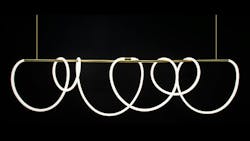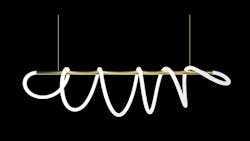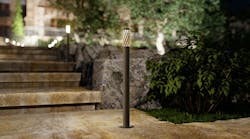Flexile, a supple, adjustable light engine, can be draped and shaped to create custom chandeliers with the look of traditional 360° neon. The Inspire Series from Tivoli Lighting is offered in five color temperature options and eight rod finishes. These features allow the personalization of the finished chandelier to reflect the architectural, entertainment, commercial and food-grade environments in which the luminaires can be used.
The silicone light engine at the heart of the Array and Eos luminaires is stabilized to withstand exposure to ultraviolet light without yellowing or cracking. The material also resists saline solutions, acids, alkalis and corrosive gases. The luminaire is IP54 rated to prevent dust or particle contamination.
The flexible linear lighting is paired with fixture and hang-straight rods. The Inspire Array couples two 16.25" light engines with 96" and 72" horizontal rods. Inspire Eos has a single 16.25" light engine with 48" and 72" horizontal rods. The field-cuttable hang-straight rods can be used to create any finished hanging height for the fixtures although fixture ceiling heights typically are between 27" and 48".
Designed to operate on 24 V DC power, the chandeliers consume 73.1 to 146.25 W per unit.
Technical Features
- Light engine: Inspire Array has a 32.5" light engine (two pieces at 16.25"); Inspire Eos has one 16.25” light engine
- Distribution/beam angle: 360°
- Light colors: 2300K, 2700K, 3000K, 3500K, 4000K; all 95+ CRI
- Efficacy: 66.7 to 76.7Lm/W
- Mounting methods: Flush canopy, minus mount, or T-bar installation
- Housing: UV-stabilized, food-grade environmental silicone; rod finishes include satin, vintage and brushed brass; black; white; natural and polished aluminum; and brushed copper
- Control: Dimming is achieved through TRIAC, ELV, MLV, 0 to 10 V, and DMX






